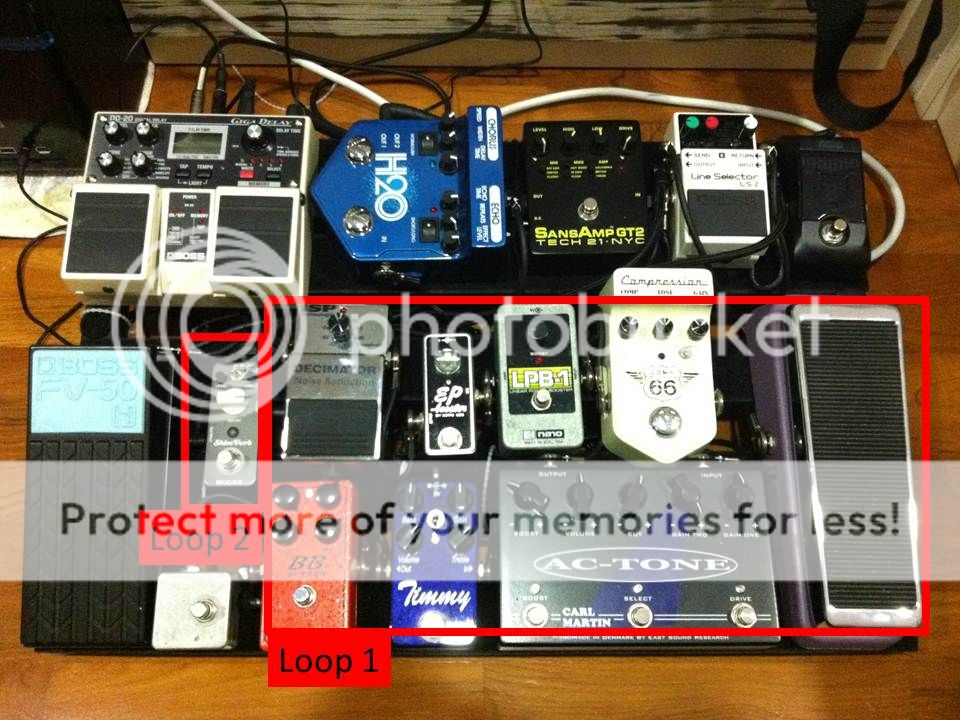 This was a quick experiment in tone crafting:
This was a quick experiment in tone crafting:- What if I removed all the various power supplies and just relied on one 9V adapter like the One Spot?
- What if I removed the Deluxe Electric Mistress (update: I sold it off eventually), which was non-true bypass and had a bulky 18V adapter?
- What if I removed the Carl Martin AC Tone, removing the first layer of overdrive?
What inspired such a radical experiment? At the last rehearsal before Music Extravagant with YFC, Richard said to me, "The only one who's niao (trans. picky) about your tone is you." Don't worry, he didn't say that in an acrimonious way (I think we were talking about tone requirements, and how all he wanted was only a wah/overdrive/delay sound, and anything else in the equation was at my discretion). Yes, electric guitarists tend to be very niao about tone. We think that in order to squeeze as much tone as possible out of one pedal, we need to have two to three others to complement it. How often have you heard guitarists say things like:
"Yes, that Timmy is fantastic! But it really needs an already-slightly broken up tone to really get the shimmer right. So I'm getting a TS808 before the Timmy."
"Yeap, I have two delays in my rig, each one at a different delay time so that I can get a cascade of delay tone that doubles as a reverb."
Observation #1: No AC Tone
My primary use of the AC Tone was to have the first drive always on--it was set up for a slightly-broken-up tone, like an amp at the breaking point. Without the AC Tone, it's pristine clean now, and I had to get used to that tone. And you know what? I found the clean nuances of my guitars. The distinct differences between single coils and humbuckers were so much more evident.
I was a little lost without the boost function of the AC tone (I used the boost to push my lead tone into my solo tone), but I soon replaced that with my second EP booster. Carl Martin boosts are clean and non-colored, so with an EP, the boost has an EP flavor: fat, slight-smiley face, and compressed. It certainly was very different, but definitely a useable tone.
Observation #2: No Deluxe Electric Mistress
Yeap, I knew it. The 18V adapter was the cause of hum in my rig. Removing it from the chain had a distinct clean-up of white noise, hum and artifacts. There was even a brightness in my tone that I never knew was there--perhaps my ears were too used to the tone of non-true bypass. If I were to be honest, I had the DEM on my rig more for cosmetic than tonal reasons. '70s-style flange is nice, but it's a lot harder to incorporate that in a song than the tried-and-true tone of chorus. So the verdict is final: I'm removing the DEM permanently!
Observation #3: Removing Power Supplies
By having all the pedals running off a single One Spot, I realized that there's a loss of "mojo" in the pedals that can run on higher voltages like the BB Preamp, the Timmy, and the EP boosters. They sound nice at 9V, with a sound that's more compressed and less headroom, but they sound even better when cranked to 18V. But perhaps the biggest change is that they respond differently to the use of my guitar volume knob to clean up an overdriven tone. At 18V, I seem to be able to capture the nuances of everywhere between 0-10 in small increments (0, 1, 2, 3...10). At 9V, I lose that subtlety and it sounds like I can only vary from 0-10 in bigger increments (0, 2, 4, 6...10).
That being said, the removal of the DC brick helped to reduce the noise in my rig. It's dead quiet! It appears that I can only have one or the other: magic with noise, or less magic with no noise.
Summary
I need more tonal variation. While having a pristine-clean tone is nice, I'd rather have the first-layer overdrive of my AC tone to add some dirt into the next few overdrives. Stacked overdrives to my ears just sounds nicer than single-overdrives. I also can make do without the DEM, which will free up the space on my pedalboard and reduce the noise significantly. Finally, I will put back the DC brick so I can run the overdrives and EP boosters at 18V to have the extra clarity, headroom and "mojo".

















